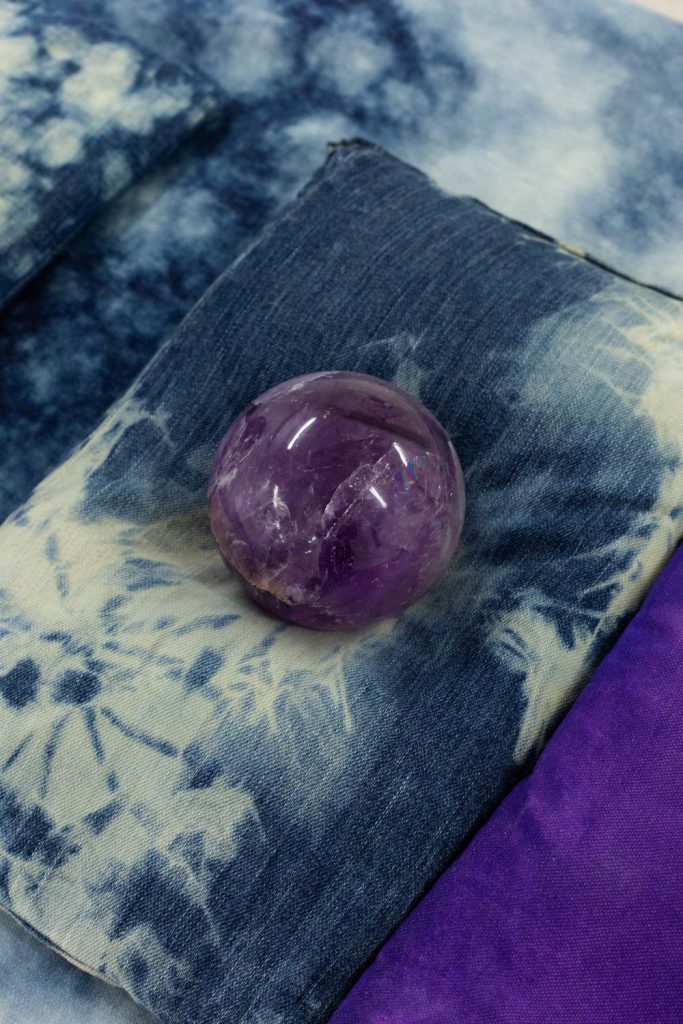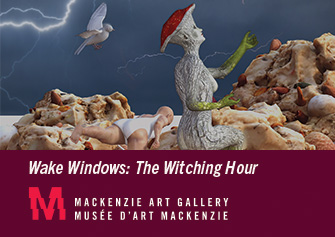Making your way under darkness: Moonshow at the plumb
25 May 2022
By Dana Snow
The Moon is the eighteenth card in the traditional Rider-Waite Tarot deck. When the Moon reveals itself in a reading, it signifies that a time of reflection, intuitive dreaming and evolution lie ahead. The moon whispers softly to us and guides us to the gates of the unknown, insisting on a balance of light and darkness. Moonshow, curated by Tkaronto-based collective Hearth, and exhibited at the plumb in the city’s midtown, lapped at the viewer’s consciousness like the moon pulls the tide: reflection, cyclical repetition and vibration act as guiding forces through the serpentine project space. The exhibition was on view from January 9th until February 7th, 2021, a time that could only be described as desperate in terms of Tkaronto’s COVID-19 crisis. This show underscored the importance of embracing darkness in dark times, offering a respite to the ever-climbing numbers in the crowded city with saccharine appeals of “hope” that other contemporary exhibitions did not.
Organized between Hearth and the plumb as a sister show to Sentient Sun, an exhibition at Hearth Garage in summer 2020, the intentional move toward balance in programming enhanced the sense of dualism throughout Moonshow. This dualism, centred between material reality and spectral presence, rules the layout. Aptly noted in Hearth’s accompanying publication, the gallery’s two adjacent rooms “refract along the asymmetrical warp of the scrying bowl,” tying the static energy of the east gallery and the movement of the west gallery together into the water of the scrying bowl that radiates future potential. The bowl implies two presences: one that looks forward and one that looks back, a binary tension in which the main themes of the show operated. Works by artists FASTWÜRMS, Holly Fedida, Julian Yi-Zhong Hou, Chantal Khoury, Aidan Koch, Alicia Nauta, Shaelynn Recollet, Fatine-Violette Sabiri, and Véronique Sunatori interconnected like poetic free-association, embracing the great unknown magic of the moon by unveiling the unconscious connections in the work. In a conversation I had with Rowan Lynch, a member of the Hearth collective, the two rooms of the plumb’s basement project space are described as “lungs.” It’s a good metaphor as the works inhale and exhale as one traverses the path so cleverly arranged by the exhibition’s layout. An unnameable familiarity follows the viewer throughout the space, and the curatorial choices exude a sense of déjà-vu by playing with graphic matching and pairing similar textures and colours of works within the same room. Hearth’s curatorial design choices are augmented by the plumb’s unique architecture, playing with reversals and symmetries.
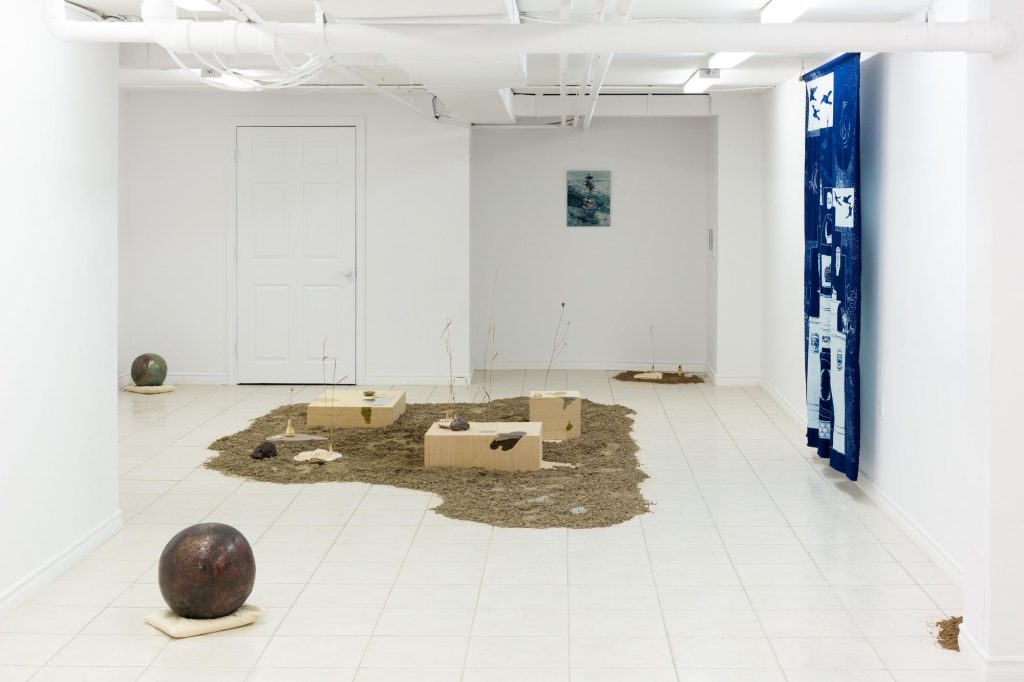
The east room of the gallery presents a static meditation space, represented most clearly in FASTWÜRMS’ Celestial Massage (2017), a divine denim massage table with raku and crystal orbs reflecting weighty points of an absent body. A scrybowl at the head of the massage table seems to beckon an astral body on top of the work. This is the first implication of the absent body in the exhibition, reiterated again through Véronique Sunatori’s sculptural intervention, It will come like a wave (2017), of footprints in sand. One becomes aware that the viewer is not the only presence in the room. Body doubling also appears in Chantal Khoury’s Mary II (2020) and Mary IV (2020). The paintings of Our Lady of Lebanon are inverted reflections of one another: Mary II is embodied in deep cyan at the entrance of the east room, oily brushstrokes bathing the figure in reflective light, while Mary IV stands in stately opposition across the hallway in the west gallery—the image flipped, in creamy red and pink impasto. Shaelynn Recollet’s Pshaagiizhibkte (The Darkness) “The darkness where all things began – our culture, language, and ways of knowing” (2020) reminds the viewer of the darkness of the womb—a darkness that feels like coming home to the lights off, and the kind which surrounds us in rest and in sleep. I am reminded that when the Moon card is drawn, a time for nurturing the shadow-self is upon the querent.
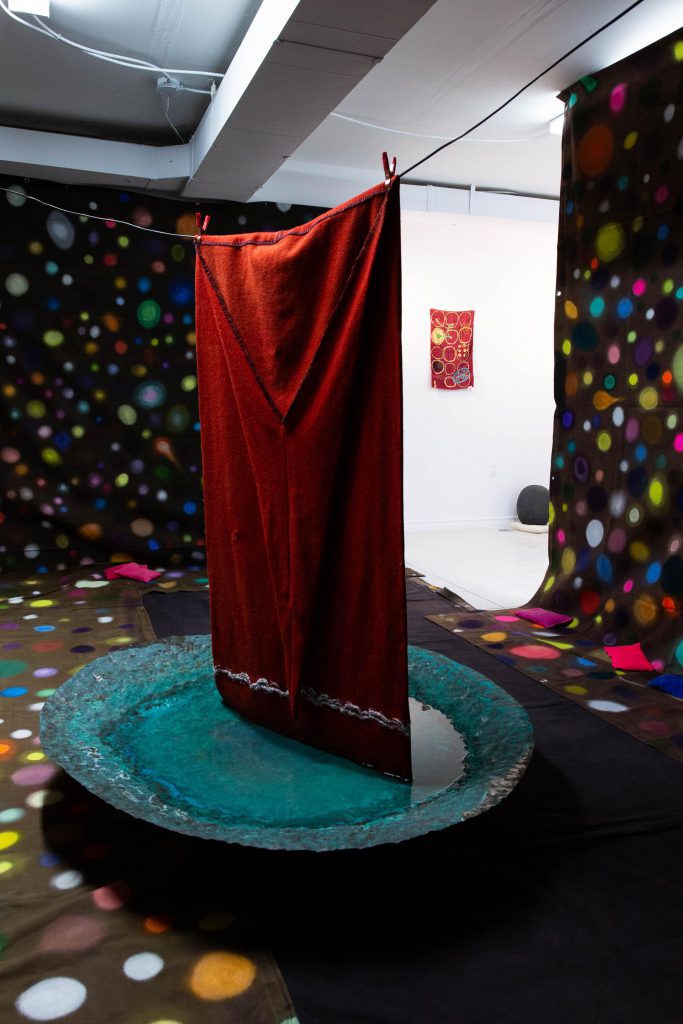
Resting as porous markers in corners and entranceways, orbs by FASTWÜRMS guide the viewer through the space. The names of these weighty clay spheres, Nu Moon, Copper Moon, Dragon Moon, Moss Moon (all 2018), and Azurite Moon (2021), recall the moons of the lunar calendar—nomenclature likely derived from Omàmiwinini (Algonquin) culture, refashioned and popularized in a Farmer’s Almanac print in the 1930s.1 Recasting these names marks the objects as otherworldly, signifying a different approach to the measure of time and season. Alchemical in nature, the orbs are made by raku, a Japanese pottery technique involving the use of all four elements: clay from the earth, fire from the kiln, water to cool the clay, and wind during the oxidation of the metals in the material that produce colour.2 The outcome of the raku process is unpredictable, as using unstable and combustible elements requires a more passive and intuitive approach to their making. FASTWÜRMS bend time and elements into a simulacrum of the lunar cycle, imbued with the possibility of chance, change, and new beginnings. The presence of an alternative way of operating emerges in the series, encouraging a lax drift into the unknown, like the water gently flowing between two towers in the Moon Tarot card.
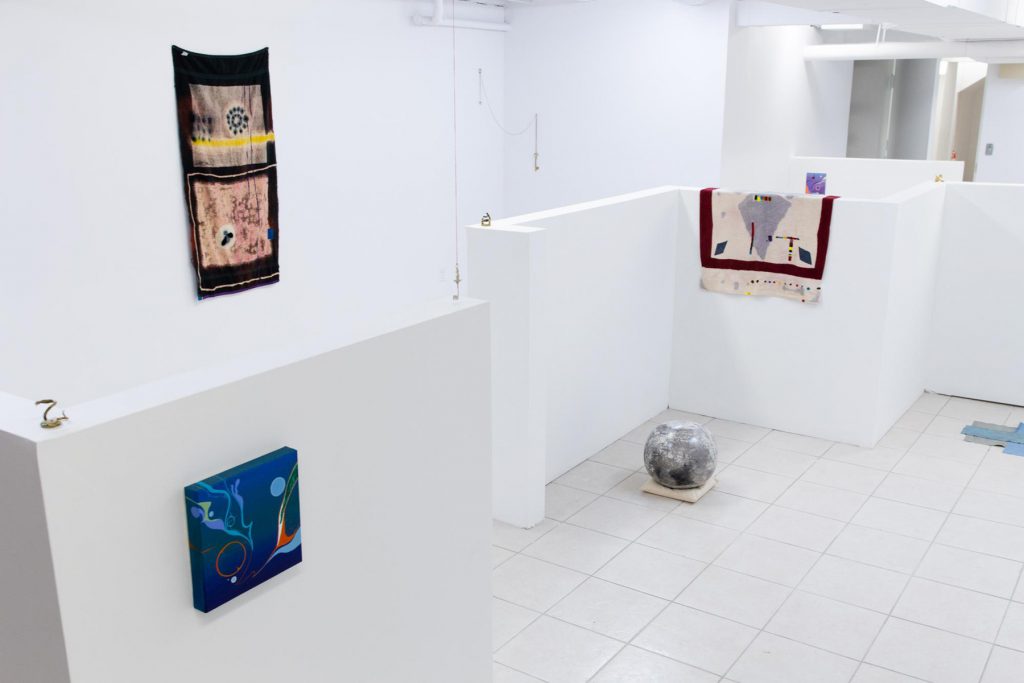
While the east gallery invokes stillness, the adjacent gallery couples meditation with exothermic energy, asking the viewer to experience the works through movement. Two of Hearth’s members, Rowan Lynch and Benjamin de Boer, collaborated on labyrinthine walls stretching upward and dividing the room. An ancient symbol of meditation, ritual and city-building, the labyrinth encourages the viewer to ruminate on the artworks in the room. Like ivy to a trellis, the contained artworks grow around and spill into the erected half walls. Built to evoke the “one true path” of ancient labyrinths, the structure occludes other works in the room as one travels through it.3 Aidan Koch’s delicate brass works are suspended above each perpendicular intersection of the labyrinth in red thread, balancing the weight of the intervention with gentle airiness, while the placement of Julian Yi-Zhong Hou’s inviting Cartomantic Quilt (2020) encourages the viewer to be aware of the floor that grounds them.
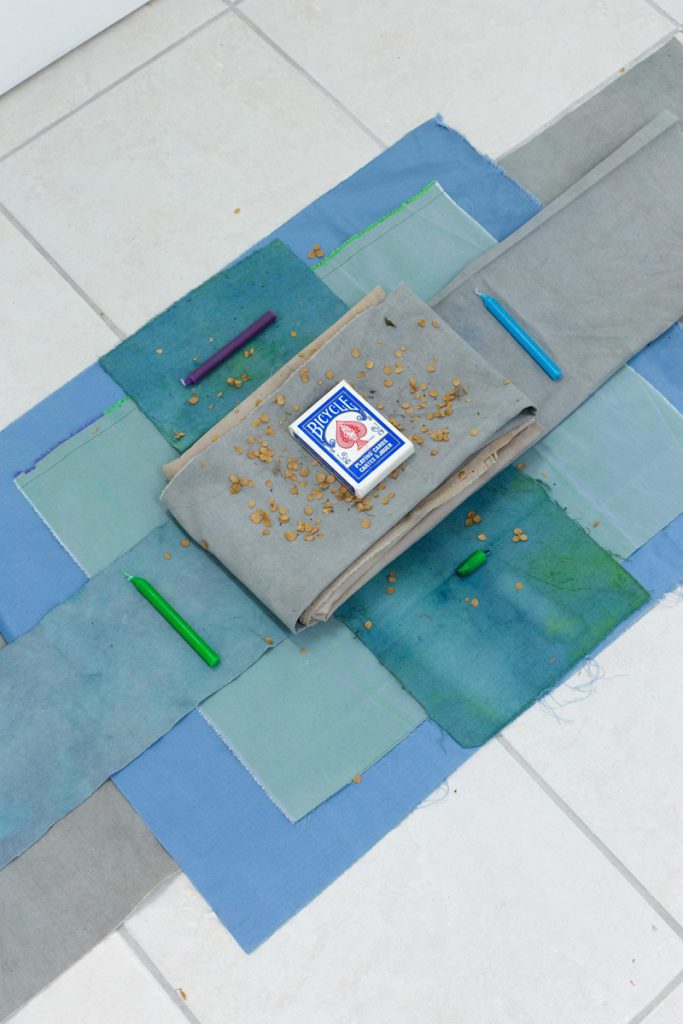
The quilt, activated by a collaborative meditation from the members of Hearth on the palindrome date of January 20, 2021 at 12:21pm, lays in a quiet alcove of the erected winding half walls. A Bicycle brand card deck sits at the centre of the work, circled by chime candles. Dried clover leaves rest beneath the deck, scattered as if by a strong breeze atop the found textiles, which are also remnants from the artist’s previous exhibition, Grass Drama at Unit 17 in Vancouver. Mirroring the invitation to the spectral body in FASTWÜRMS’ Celestial Massage, Cartomantic Quilt brings the viewer’s attention to the bodies that are not physically present, the act of reading the cards has passed, but the residual sense of occupancy remains. This haunting sensation floats through the gallery space, connecting itself to various other pieces through graphic matching.
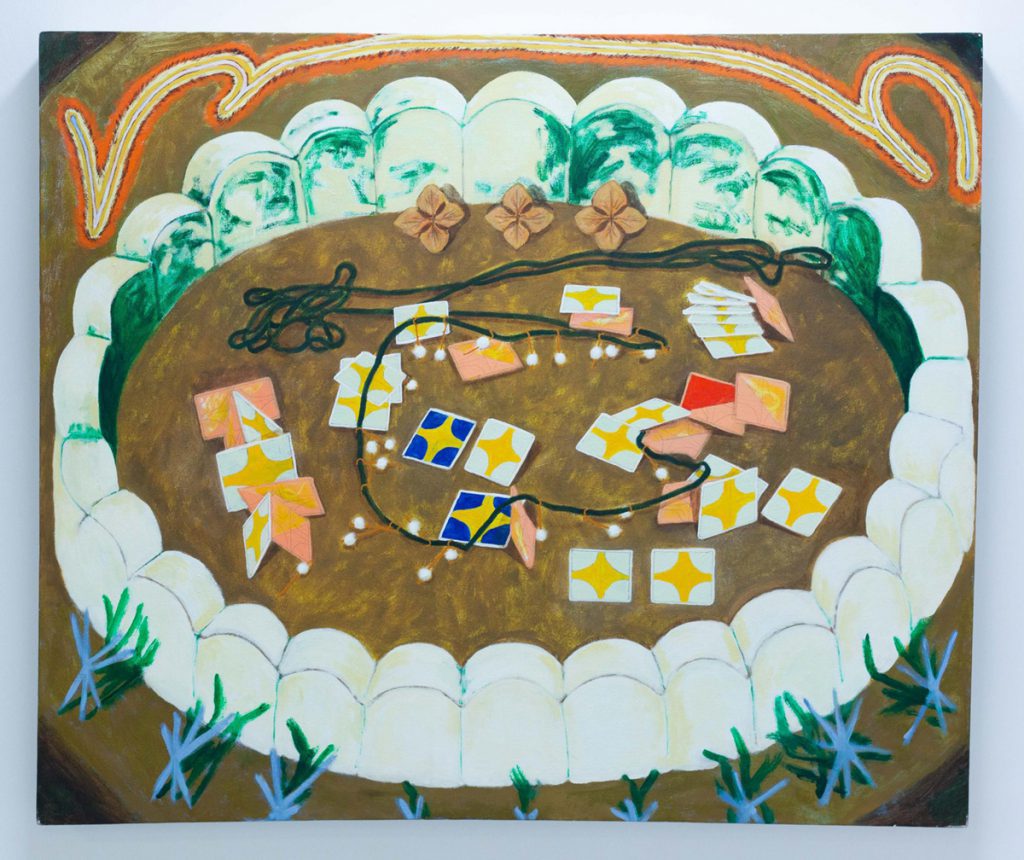
Holly Fedida’s Some Pieces (2020) hangs directly within the eyeline of Cartomantic Quilt. Depicted within the work is an enclosed circle of sand grey stones surrounding diamond-plated cards, foretelling destiny and major life changes in cartomancy. The diamond also appears in Fatine-Violette Sabiri’s Tarablous Terrazzo (Saïd) (2019), draped carefully to the right of the quilt. This feeling of an otherworldly presence is amplified by the scrying bowl in FASTWÜRMS’ The Hermit (2017): calcium chloride (salt) and water rest together in the greening bronze of the bowl, slowly seeping upward into a scarlet red melton blanket suspended by clothespins on copper wire. The chemical reaction between the water and salt charges the room with excess energy, a palpable shift that makes the basement air feel physically lighter.
The last time someone did a Tarot card reading for me, he pulled the Moon. He told me that it was time to peer into the shadows, embrace and accept the fear of the dark and move forward intuitively. This was before the global pandemic, but that advice is much more relevant now. Embracing darkness as a compliment to light, Moonshow emphasizes quiet stillness, introspection and faith as leading values in dark times. The exhibition fuses shadow and light, using carefully considered curatorial and artist collaboration to balance and activate both the gallery space and the artwork with a great unknown—something akin to magic. The myriad works and the symmetry of the exhibition’s design encouraged the viewer to look inward, validating dark aspects of one’s physical and spiritual self and providing guidance through the wobbly curvature of the scrying bowl.
- https://inews.co.uk/news/long-reads/wolf-moon-full-january-2021-meaning-names-why-science-448478
- https://en.wikipedia.org/wiki/Raku_ware
- From a personal conversation with Rowan Lynch.
Moonshow ran from January 9 – February 7, 2021 at the plumb in Toronto, ON.
Feature Image: Celestial Massage, 2017 (detail view) by FASTWÜRMS, courtesy of Paul Petro Contemporary Art. Photo by Alison Postma courtesy of the plumb and Hearth.

